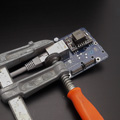HTTP callback optimization
 Some weeks ago, we published an update of our libraries which reduces the quantity of transferred data between the Yoctopuce modules and the API. However, this optimization wasn't available for HTTP callbacks. This week, we publish a new PHP library which enables you to take advantage of a similar improvement for HTTP callbacks.
Some weeks ago, we published an update of our libraries which reduces the quantity of transferred data between the Yoctopuce modules and the API. However, this optimization wasn't available for HTTP callbacks. This week, we publish a new PHP library which enables you to take advantage of a similar improvement for HTTP callbacks.
| 2 comments | Read more... |
Automating YoctoHub configuration
![]() YoctoHubs allow you to make available any Yoctopuce module from an Ethernet or Wifi network. This enables you, for example, to use several temperature sensors in distinct buildings. However, before you can access a YoctoHub through the network, you must first configure its network parameters. You can use the VirtualHub or our command line tools, but this week, we are going to see how to automate this step using our libraries.
YoctoHubs allow you to make available any Yoctopuce module from an Ethernet or Wifi network. This enables you, for example, to use several temperature sensors in distinct buildings. However, before you can access a YoctoHub through the network, you must first configure its network parameters. You can use the VirtualHub or our command line tools, but this week, we are going to see how to automate this step using our libraries.
| No comment yet | Read more... |
Performance improvement of our API
 This week, we are going to talk again about our programming libraries, to announce a good news: We added an optimization which reduces running time by about 40% and splits by half the quantity of transferred data.
This week, we are going to talk again about our programming libraries, to announce a good news: We added an optimization which reduces running time by about 40% and splits by half the quantity of transferred data.
| No comment yet | Read more... |
How to get started in C# with Yoctopuce modules
![]() This week, we show you how to make a Windows application using Yoctopuce modules, in C#. The exercise is interesting because most C# examples provided with the Yoctopuce API are actually console applications. Windows Forms applications introduce some small differences which you should note. Note also that this post doesn't pretend to teach you C# programming. You are supposed to have some knowledge of it already :-)
This week, we show you how to make a Windows application using Yoctopuce modules, in C#. The exercise is interesting because most C# examples provided with the Yoctopuce API are actually console applications. Windows Forms applications introduce some small differences which you should note. Note also that this post doesn't pretend to teach you C# programming. You are supposed to have some knowledge of it already :-)
| No comment yet | Read more... |
Fancy ringtones for the Yocto-Buzzer
 The Yocto-Buzzer is a small module enabling you to provide an acoustic ack to the user, which is particularly useful when you work with a mini-computer without a soundcard or when you work remotely through the network. To ease the use of the Yocto-Buzzer, today we present a simplified method to generate short jingles.
The Yocto-Buzzer is a small module enabling you to provide an acoustic ack to the user, which is particularly useful when you work with a mini-computer without a soundcard or when you work remotely through the network. To ease the use of the Yocto-Buzzer, today we present a simplified method to generate short jingles.
| No comment yet | Read more... |


